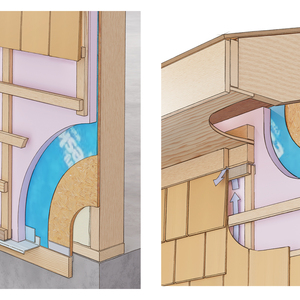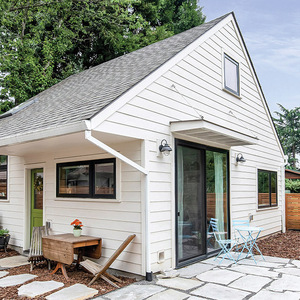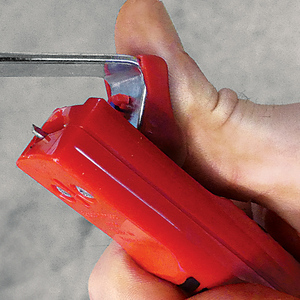Somebody, in response to my recent dormer thread, suggested that I post “specific questions” about the job so here’s my first:
I’ll be approaching the tear-off sometime soon and what I’m dealing with is a roof on a 1925 Craftsman Bungalow that is shingles over horizontal strips of 1X4’s spaced about 3 inches apart and running up the slope of the roof. In other words, no 1/2″ cdx sheathing! This makes the prospective buttoning-up of the new dormer structure ‘dicey’… the step flashing along the sides, for instance, would not have a solid structure beneath them for aprox. half the length of the run.
I’m wondering if building/retrofitting the new shed-dormer into the old roof will necessarily need to involve stripping and sheathing the roof … in other words … re-roofing that entire side of the house, when it doesn’t really need a new roof!
Any thoughts on procedure regarding this situation greatly appreciated.
BTW — r.e. my previously recent post on the sparsity of info on shed-dormer retrofitting … the taunton book, Framing Roofs from Fine Homebuilding has a totally detailed step-by-step explaination of how to proceed with it. (Does not, however, address the question of this post in any way.)
Thank you –
Terry



















Replies
You don't mention what type of roofing, although I would guess that since you have skip sheathing, that it is probably cedar shingles or shakes. If it is cedar, then having skip sheathing will not affect your step flashing, since each flashing rests over the shingle below it, which spans the space between the strips of sheathing. Depending on the condition of the roof and other factors, you may not have to re-roof the whole side, but you will have to "tooth" the new shingles at the sides of the dormer together with the old, which can be a challenge with cedar, especially if it is older and prone to cracking. The most foolproof way of doing this is removing the shingles back up the roof, taking one more shingle away in each row as you move up. This leaves a staggered line of shingles that can be patched with new shingles and then step flashed as though it were a new roof. Trying to piece the shingles back together in a straight line going up the roof along the dormer can be done, but it requires patience, some luck, and some experience.
Wow! .. clearly an experienced roofer speaking. Which I am not.
It's cedar shakes over the skip sheathing and then a course of asbestos 3-tab over that. I guess the 'proper' way would be to 're-do' that whole side - at least - with sheathing. But I'd like, for once, to think that it might be possible to actually simply do the job I'm wanting to do without having it necessarily bleed into requiring a whole 'nother job ... and equally as large .. which I wouldn't have otherwise undertaken. Since all systems tie-in to one another these jobs seem to draw one towards progressively re-building the entire house.
Anyway .. thanks for the expertise ... I don't know what 'toothing shinges' is ... but I'm going to go ahead with it all and hope to get away with flashing it without completely re-roofing that side. UNLESS .. someone convinces me otherwise. It's not THAT big a roof ... maybe I should, and use this as my 'learning project' for roofing.
Terry
(bump) any other input on this?
Terry - let's clarify for a second. You said three tab asbestos. Any chance you meant three tab asphalt? It will have a big impact on what you're trying to do. If it is asbestos, aside from the health and safety issues (you may need an abatement specialist just to remove it) you are going to have trouble getting new shingles to repair where you have to insert the stepflashing.
Regardless, you are going to want to make the dormer size to fit between existing rafters, with the side wall of the dormer up against the existing rafter. This will give you the ability to make a nice clean cut in the old roof by using a sawzall and guiding the blade along the side of the rafter. This will also give the existing lath and shingles something to stay attached to. This means the sidewall of the dormer will be framed like a conventional wall, sitting on the floor of the room and up against the rafter (leave room for sheathing), rather than framed on top of doubled rafters the way you may see in some diagrams.
Actually, if you were to do it this way, and you were LUCKY enough to cut the shingles straight without damaging them, you could insert the new step flashings from the side, prior to erecting the wall, and avoid the whole hassle of having to try to tie all the shingles back together again. I wouldn't, however, plan my entire project around doing this, since you won't know if it's going to work until you try.
If your shingles are asphalt, I would disregard the above and just pull them off and patch in new shingles and flashing, because it is much easier. I would still erect my walls to the interior of the existing rafters, though. It will make cutting through the existing roof much, much easier.By the way, not a roofer.
Edited 3/23/2005 4:19 pm ET by Nick Pitz
Nick,
Thanks for the great explanation of the process. Yes .. of COURSE I meant 'asphalt' ... donno, now, how 'asbestos' got written!
I'm a little stunned by the realization of how much simpler it (seems) it would be to do it the way you describe. Since my original posting I've had the opportunity to look at a number of diagrams and not ONE of them illustrates the procedure ala that fashion. Every single procedural explanation I've found illustrates how to build the new sidewalls ONTO the outside existing rafters. But building them in the traditional manner and up AGAINST the outside rafters would actually seem to make more sense! The ONLY reason I can see -- at least initially here .. having just seen your suggestion -- for NOT approaching it that way would be the extra half a foot or so of final inside room width that the traditional approach would assume.
Were you suggesting this 'alternative' approach simply on the basis of the fact that the roof is not sheathed? ... is skipsheathed? ... in order to provide the necessary support that I was worried about? I'm sort of now wondering why it's not ALWAYS done this way, plywood sheathing or not!
Again, thanks for the great suggestion. Got me thinkin' from a whole new angle.
Terry
hi, nick.. how's spring looking ?
terry... are you building this right up to the gable end ?
if so.. you have three considerations..
1)all the way to the end gives you the most room
2) set back from the gable end looks a lot better ..
3).. if you are going to roof this small section of the main roof, it either has to be wide enough to stage or narrow enough to reach from a ladder
i like to set full dormers a minimum of 3' back from the edge.. ( two rafter bays will be about 32" .. close enough )Mike Smith Rhode Island : Design / Build / Repair / Restore
Mike,
This shed-dormer is on the extremely hidden back side of a house that needs more sq-footage ... hence, all the way out to the house foundation line. (When u say 'gable end' I'm not certain of your meaning ... so .. hope I'm making sense to you in terms of what you meant.)
It'll be wide enough to roof .. and I'm going to have to decide between epdm and 3-tab... depending on the slope I end up creating, I guess.
Terry
terry... when a dormer goes all the way to the ends of the structure.. it is no longer a dormer.. it's a bastard roof..
it is often done in tract housing to expand the living space... but it is not attractive.. and can be plainly seen from three sides ( all except the front )..
designers sometimes nail trim onto the ends to simulate the old roof line that is buried by the "dormer"Mike Smith Rhode Island : Design / Build / Repair / Restore
Hey Mike - Hope you and Helen are well... Spring is looking like the inside of a wood shop... I'm semi-retired from remodeling... other than that, things are good. Hopefully we'll get a chance to come out to Riverfest.
Terry - Yes, my advice to frame the wall to the inside of the existing rafter is based on the fact that it is skip sheathed and has cedar shingles. My personal experience is that trying to cut through all that between two rafters will end up making a big mess by shaking everything loose, and then you will need to install a new rafter anyway to support the cut ends. Another potential advantage of doing it this way is getting better insulation; if you frame the wall on top of the rafter, you have a large area of thermal bridging going right throught the middle of the wall. There are, of course, some potential disadvantages, one of which you have already figured out... losing some interior space. Another is that although the sidewalls of the dormer are not technically load bearing, they are carrying at a minimum their own weight plus the wight of anything hung on them. Assuming for a second that the floor joists of the new dormer are parallel to the side walls, I would generally recommend having a floor joist (or doubled floor joist) underneath them, or at the very least some solid blocking. Otherwise, you are relying solely on the spanning strength of whatever subfloor is underneath them. You could probably get away with it, but depending on the conditions, it shouldn't be a big deal to have some kind of support under the plate. Of course, you could always cut the existing roof back the edge of a rafter, then sister two new rafters to the inside, and frame your wall on top that.. There are lots of possibilities, and every situation is different. It's a good idea to think through all the possibilities, and some good professional advice (not via the internet) could save you a lot of time and effort...another issue you have to contend with when building big shed dormers is the tendency of the other, steeper side of the roof to want to push the ridge... adequate collar ties or other reinforcement has to be considered.
Edited 3/24/2005 6:34 pm ET by Nick Pitz
Mike,
We may be mis-communicating ... I'm not burying any rooflines. This dormer DOES 'sit' on the back corner of the house ... coming straight up from the first floor walls of of the South corner ... but there's another two feet of roof overhang off of the inverted-vee end (donno roof terminology) beyond the dormer-side ... and a two+ foot apron extending beyond the back wall of the house, (front of the new dormer), which covers a back porch and supports the gutters. Also .. the dormer will only extend about 11 feet north along the way of a 26 foot roof... so it's definitely a dormer and NOT, I think, what you are refering to as a 'bastard roof'. though, admittedly, perhaps a bit of a 'bastard's roof'. But that's another story. Thanks.
Nick,
Lots of good stuff to consider. Your postings have totally altered what I'll now be doing ... kind of amazing, that. The floor joists, luckily, run perpendicular to the side walls and are VERY strong under 3/4 t&g ... a 'floating' floor that I built last year, and, as is my paranoid style, definitely OVERbuilt. Hence, I would/will feel fine about placing sidewalls upon it. Definitely fortunate in that, I'd say. And I will definitely 'build' the entire structure ... point by point .. in my mind before picking up the saw and hammer.
Maybe I'll try and post some pictures of the progress with results.
Thanks again!
Terry